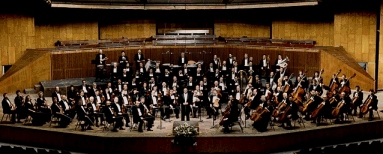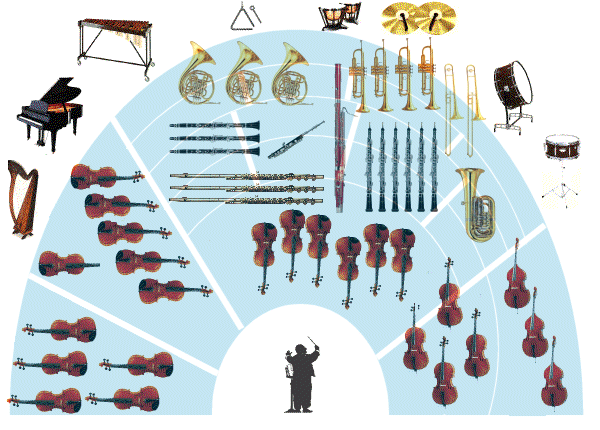|
Xtend
 Listen
Listen
 Evolution
Evolution
 Dictionary
Dictionary
 Internet
Internet
 Projects
Projects
|

Kinds
Normally placed on a stage, the symphony orchestra  performs symphonies
performs symphonies ,
symphonic poems ,
symphonic poems ,
concertos ,
concertos ,
and other concert music. The orchestra is a large group of musicians made
up of string, brass, woodwind, and percussion instruments. A chamber
orchestra ,
and other concert music. The orchestra is a large group of musicians made
up of string, brass, woodwind, and percussion instruments. A chamber
orchestra consists usually of 25 or fewer players. Most orchestras before 1800 were
of this size, and many 20th-century
consists usually of 25 or fewer players. Most orchestras before 1800 were
of this size, and many 20th-century composers call for chamber orchestras. A string orchestra
composers call for chamber orchestras. A string orchestra ,
usually of chamber-orchestra size, consists of the standard orchestral
string section, but with no added percussion or wind instruments. Ballet
and opera orchestras are part of theatrical performances and are seated
in the orchestra pit of a theater. Unlike symphony orchestra, a philharmonic
orchestra is not a type of orchestra. ,
usually of chamber-orchestra size, consists of the standard orchestral
string section, but with no added percussion or wind instruments. Ballet
and opera orchestras are part of theatrical performances and are seated
in the orchestra pit of a theater. Unlike symphony orchestra, a philharmonic
orchestra is not a type of orchestra.

History
The modern orchestra has practically existed since the
17th century .
Instrumental ensemble music before that time was, in most cases, chamber
music. Only occasional ceremonies brought as many available instruments
to be massed together to a big orchestra. Until that century, there thought
little to specifying what instrument should play a given part, since the
usual thought was that any available instrument with the proper range would
be suitable to play a part. .
Instrumental ensemble music before that time was, in most cases, chamber
music. Only occasional ceremonies brought as many available instruments
to be massed together to a big orchestra. Until that century, there thought
little to specifying what instrument should play a given part, since the
usual thought was that any available instrument with the proper range would
be suitable to play a part.
Through the baroque period, the development and standardization of the modern orchestra took
place. In 1607, Monteverdi
period, the development and standardization of the modern orchestra took
place. In 1607, Monteverdi used an orchestra in the first major opera, "The
Legend of Orpheus" (La favola d’Orfeo),
having a central string section augmented by other instruments and bound
together harmonically by basso continuo
used an orchestra in the first major opera, "The
Legend of Orpheus" (La favola d’Orfeo),
having a central string section augmented by other instruments and bound
together harmonically by basso continuo ,
which means bass melody instrument, such as a cello ,
which means bass melody instrument, such as a cello or bassoon
or bassoon ,
plus harmony instrument, such as harpsichord ,
plus harmony instrument, such as harpsichord or organ
or organ . .
A virtual tour in the concert hall
 
Sections
Certain proportions have proved to give the most effective
balance of sound in the strings; an orchestra with 20 first violins and about the same number of second violins,
14 violas
and about the same number of second violins,
14 violas ,
12 cellos ,
12 cellos ,
and 8 double basses ,
and 8 double basses .
Although these numbers may vary, they are considered representative. .
Although these numbers may vary, they are considered representative.
During the last 4 centuries, the orchestra has changed
in terms of size, instruments and relationship between its different sections.
Study more about these changes in each of the four centuries:
|
|